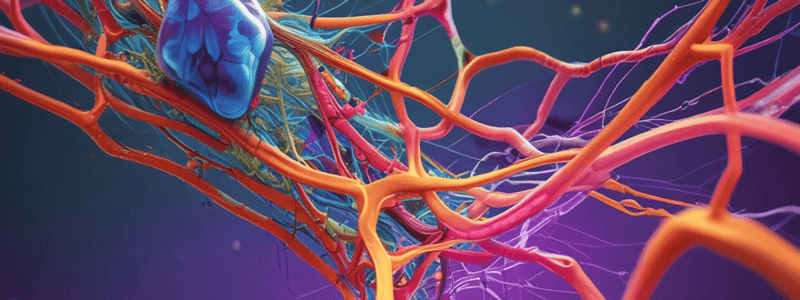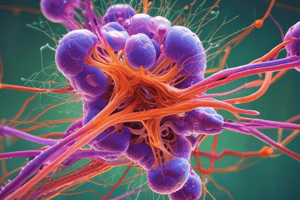Podcast
Questions and Answers
What is the main function of the cytoskeleton in a cell?
What is the main function of the cytoskeleton in a cell?
- To store energy
- To break down waste materials
- To facilitate cell communication (correct)
- To synthesize DNA
Which of the following is NOT a type of filament that composes the cytoskeleton?
Which of the following is NOT a type of filament that composes the cytoskeleton?
- Intermediate filaments
- Desmosomes (correct)
- Microtubules
- Actin filaments
What is the role of microtubules in a cell?
What is the role of microtubules in a cell?
- Directing intracellular transport (correct)
- Determining cell shape
- Facilitating cell locomotion
- Providing mechanical strength
Which structure facilitates cell membrane protrusions and increases surface area?
Which structure facilitates cell membrane protrusions and increases surface area?
What do adherens junctions represent in cell biology?
What do adherens junctions represent in cell biology?
What is the primary function of intermediate filaments in a cell?
What is the primary function of intermediate filaments in a cell?
Immunofluorescence is used for detecting which component of the cytoskeleton?
Immunofluorescence is used for detecting which component of the cytoskeleton?
Which component of the cytoskeleton helps stabilize a cell and its environment?
Which component of the cytoskeleton helps stabilize a cell and its environment?
How does a cell move forward when crawling?
How does a cell move forward when crawling?
What occurs during cytokinesis in eukaryotic cell division?
What occurs during cytokinesis in eukaryotic cell division?
Which motor protein is involved in muscle contraction in most animal cells?
Which motor protein is involved in muscle contraction in most animal cells?
What is the role of Myosin V among motor proteins?
What is the role of Myosin V among motor proteins?
What type of structures does Myosin II form in non-muscle cells?
What type of structures does Myosin II form in non-muscle cells?
Which proteins convert ATP energy into mechanical motion inside cells?
Which proteins convert ATP energy into mechanical motion inside cells?
What drives motion inside cells in association with parts of the cytoskeleton?
What drives motion inside cells in association with parts of the cytoskeleton?
What is the function of Actin in forming contractile structures?
What is the function of Actin in forming contractile structures?
What type of protein crosslinks actin filaments to form more rigid linear bundles?
What type of protein crosslinks actin filaments to form more rigid linear bundles?
Which protein accelerates the depolymerization of actin filaments?
Which protein accelerates the depolymerization of actin filaments?
What is the function of ATP-bound actin in the context of actin filaments?
What is the function of ATP-bound actin in the context of actin filaments?
Which type of crosslinker force actin filaments to align closely in parallel arrays?
Which type of crosslinker force actin filaments to align closely in parallel arrays?
What accessory protein regulates actin dynamics by inhibiting nucleation?
What accessory protein regulates actin dynamics by inhibiting nucleation?
In what state does ADP bound actin exist in relation to its stability in the filament?
In what state does ADP bound actin exist in relation to its stability in the filament?
What is the function of G-Actin subunits in actin filaments?
What is the function of G-Actin subunits in actin filaments?
What effect does hydrolysis of ATP to ADP have on actin polymer stability?
What effect does hydrolysis of ATP to ADP have on actin polymer stability?
What is the consequence of no aerobic respiration?
What is the consequence of no aerobic respiration?
How does Alpha-amanitin affect actin filaments?
How does Alpha-amanitin affect actin filaments?
Which chemical compound is the main toxic component of the death cap mushroom?
Which chemical compound is the main toxic component of the death cap mushroom?
What is the function of Phalloidin?
What is the function of Phalloidin?
How does a lack of oxygen affect ATP production?
How does a lack of oxygen affect ATP production?
Phalloidin binds to which cellular component?
Phalloidin binds to which cellular component?
Alpha-amanitin is specific in its binding to:
Alpha-amanitin is specific in its binding to:
Phalloidin can be a useful tool in studying:
Phalloidin can be a useful tool in studying:
What is the main function of the sarcoplasmic reticulum in muscle cells?
What is the main function of the sarcoplasmic reticulum in muscle cells?
In muscle contraction, what role does the binding of Ca$^{2+}$ to TnC play?
In muscle contraction, what role does the binding of Ca$^{2+}$ to TnC play?
What is the function of tropomyosin in striated muscle cells?
What is the function of tropomyosin in striated muscle cells?
What is the consequence of the absence of Ca$^{2+}$ according to the text?
What is the consequence of the absence of Ca$^{2+}$ according to the text?
What molecular event is essential for muscle contraction according to the text?
What molecular event is essential for muscle contraction according to the text?
What causes the sarcomeres to contract in muscle cells?
What causes the sarcomeres to contract in muscle cells?
What is responsible for allowing myosin-actin binding during muscle contraction?
What is responsible for allowing myosin-actin binding during muscle contraction?
What triggers an action potential in muscle cells?
What triggers an action potential in muscle cells?
Study Notes
Cytoskeleton
- The cytoskeleton is composed of three main types of filaments: actin filaments, intermediate filaments, and microtubules.
- Actin filaments provide mechanical support, allow cell movement, and maintain cell shape and structure.
- Intermediate filaments provide mechanical strength and support.
- Microtubules determine the position of membrane-enclosed organelles, direct intracellular transport, and form the mitotic spindle.
Actin Filaments
- Actin filaments are composed of smaller subunits that are elongated and fibrous.
- Each subunit is compact and globular, forming a tight, right-handed helix called filamentous actin (F-actin).
- Actin filaments are flexible and can grow by adding more actin monomers at either end.
- ATP bound actin has a higher affinity for neighboring subunits and remains stable in the filament.
- ADP bound actin can easily dissociate from the filament.
Actin Polymerization and Depolymerization
- Actin filaments can polymerize or depolymerize, allowing cell migration, interactions with the surrounding environment, and engulfing particles.
- ATP bound actin has a higher affinity for neighboring subunits and remains stable in the filament.
- ADP bound actin can easily dissociate from the filament.
- Accessory proteins regulate actin dynamics, such as profilin, which inhibits nucleation, and cofilin, which accelerates depolymerization.
Actin Structure and Function
- Actin filaments exist in different spatial arrays in cells, depending on actin crosslinking proteins (actin-binding proteins).
- Bundle-forming crosslinkers, such as fascin, form linear bundles, whereas gel-forming crosslinkers, such as filamin, form 3D gel-forming networks.
- Actin filaments support microvilli projections and can contract microvilli (associated with myosin I and calmodulin).
Actin and Cell Movement
- Actin crosslinking and cell movement are closely linked, with three main processes essential for movement: protrusion, adhesion, and traction.
- Ameba movement is an example of actin-based movement.
Actin and Myosin
- Actin and myosin are essential for muscle contraction.
- Myosin is a motor protein that causes motion inside cells in association with parts of the cytoskeleton.
- Actin associates with myosin to form contractile structures.
Muscle Contraction
- Muscle contraction is caused by a simultaneous shortening of all sarcomeres.
- Sarcomeres are highly organized assemblies of actin and myosin II filaments.
- The sliding filament model explains muscle contraction, where myosin heads interact with actin filaments, and the thin filament slides over the thick filament, causing tension.
Association of Tropomyosin and Troponins with Actin Filaments
- Tropomyosin binds lengthwise along actin filaments and is associated with a complex of three troponins: troponin I, troponin C, and troponin T.
- In the absence of Ca2+, the tropomyosin-troponin complex blocks the binding of myosin to actin.
- Binding of Ca2+ to TnC moves the complex, freeing the myosin-acting binding site, and allowing contraction to proceed.
Muscle Contraction Signal
- A signal from the nervous system triggers an action potential, which depolarizes each myofibril, releasing Ca2+ from the sarcoplasmic reticulum.
- Ca2+ interacts with the troponin complex, allowing muscle contraction to proceed.
Studying That Suits You
Use AI to generate personalized quizzes and flashcards to suit your learning preferences.
Description
Test your knowledge on the importance of proper cellular organization in space, cell interactions, and the role of cytoskeleton in facilitating key structures like Microvilli, Desmosomes, Adherens Junctions, and Apical and Basolateral Membranes.




